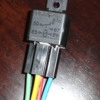I have a fluidyne radiator with flex-a lite pusher fans and my bright mechanic hooked up both radiator temp senders directly to red and black cables coming from the car without a relay so im guessing they both fried. I hooked up these cables directly to the battery and each one (red or black) power up both fans. . I want to hook up a new temp sender to a 30amp relay and power up both fans. The 30 amp relay has various inputs.Any suggestions on how to hook it up?thanks
Attachments
Original Post



